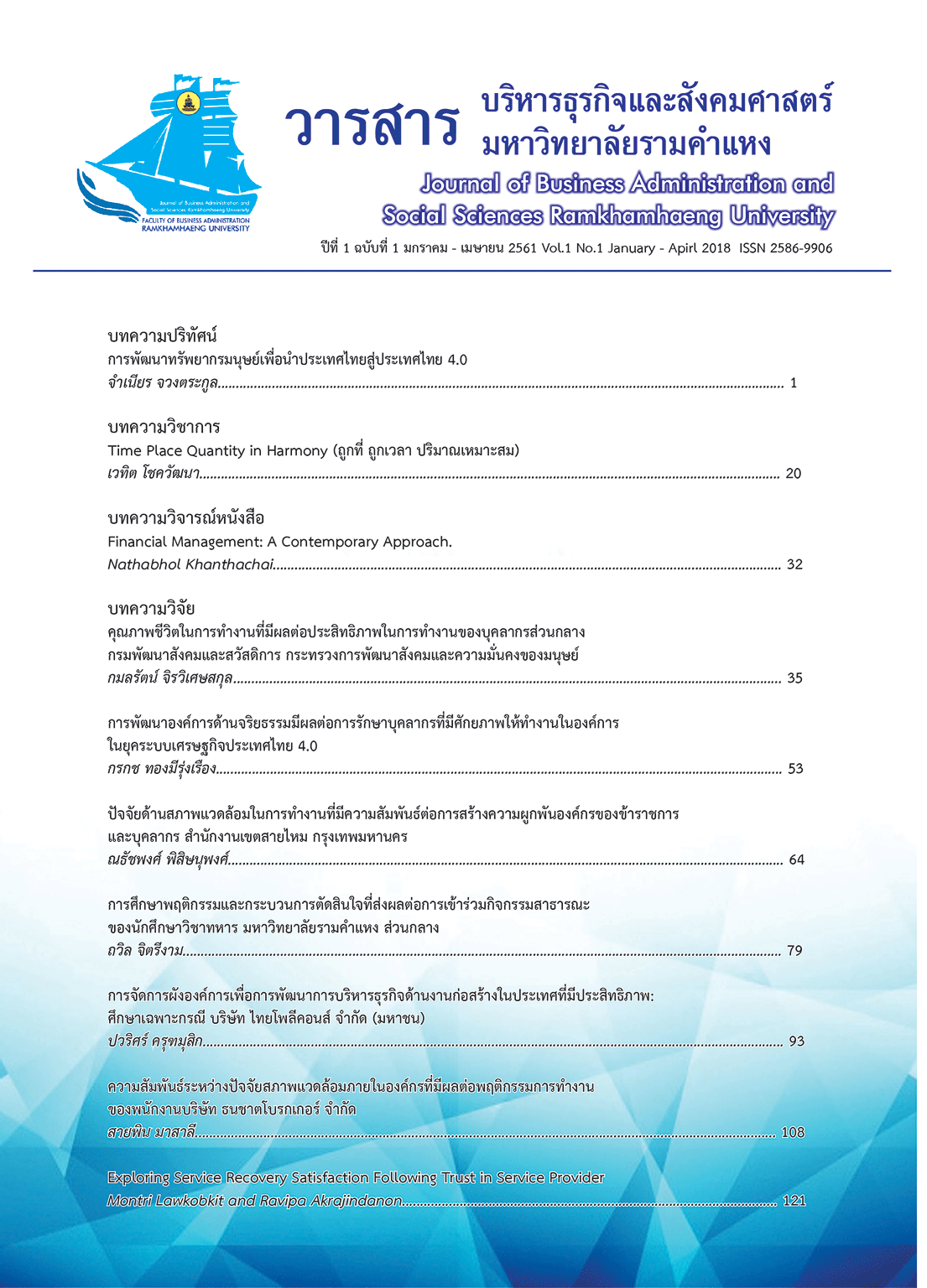การพัฒนาทรัพยากรมนุษย์เพื่อนำประเทศไทยสู่ประเทศไทย 4.0
Main Article Content
Abstract
This paper presents concepts and guidelines for human resource development to support the implementation of the government policy of Thailand 4.0. To guide this study three questions were posed: (1) "What is Thailand 4.0?"; (2) "What are the required characteristics of human resources that support Thailand 4.0?"; (3) "How to develop human resources to support Thailand 4.0?" To answer these three questions this paper will be divided into five parts: (1) Introduction to the objectives and significance of the problem; (2) Literature review which comprises: (a) the concept of Thailand 4.0; (b) the required characteristics of human resource that support Thailand 4.0; (c) human resource development for Thailand 4.0; (4) conclusions and discussion; and (5) recommendations.
Article Details
เนื้อหาและข้อมูลในบทความที่ลงตีพิมพ์ในวารสารบริหารธุรกิจและสังคมศาสตร์ มหาวิทยาลัยรามคำแหง ถือเป็นข้อคิดเห็นและความรับผิดชอบของผู้เขียนบทความโดยตรง ซึ่งกองบรรณาธิการไม่จำเป็นต้องเห็นด้วย หรือร่วมรับผิดชอบใดๆ
บทความ ข้อมูล เนื้อหา รูปภาพ ฯลฯ ที่ได้รับการตีพิมพ์ในวารสารบริหารธุรกิจและสังคมศาสตร์ มหาวิทยาลัยรามคำแหง ถือเป็นลิขสิทธิ์ของวารสารบริหารธุรกิจและสังคมศาสตร์ มหาวิทยาลัยรามคำแหง หากบุคคลหรือหน่วยงานใดต้องการนำบทความทั้งหมดหรือส่วนหนึ่งส่วนใดไปเผยแพร่ต่อ หรือเพื่อกระทำการใดๆ จะต้องได้รับอนุญาตเป็นลายลักษณ์อักษรจากวารสารบริหารธุรกิจและสังคมศาสตร์ มหาวิทยาลัยรามคำแหง ก่อนเท่านั้น
References
ข่าวสดออนไลน์. (2561). สภาพัฒน์คาดปี 60 จีดีพีไทยโต 3-4% ชี้เครื่องยนต์เศรษฐกิจจุดติดทุกตัว. สืบค้นเมื่อ 7 เมษายน 2561, จาก https://www.khaosod.co.th/economics/news_226434
จำเนียร จวงตระกูล. (2553). การพัฒนาทรัพยากรมนุษย์: ทฤษฎีและการปฏิบัติ. กรุงเทพมหานคร: บริษัท ศูนย์กฎหมายธุรกิจอินเตอร์เนชั่นแนล จำกัด.
จำเนียร จวงตระกูล. (2561). คำบรรยาย เรื่อง ทิศทางของนักพัฒนาทรัพยากรมนุษย์ตามนโยบายประเทศไทย 4.0. 5 เมษายน 2561 ณ คณะพัฒนาทรัพยากรมนุษย์ มหาวิทยาลัยรามคำแหง กรุงเทพมหานคร.
ไทยรัฐออนไลน์. (2561). ระดมพลช่วยดันไทยแลนด์ 4.0 ตั้งบอร์ด-ปรับมายด์เซ็ตคนไทยปลดล็อกอุปสรรค. สืบค้นเมื่อ 6 เมษายน 2561, จาก https://www.thairath.co.th/content/1041790
แนวคิดประเทศไทย 4.0. สืบค้นเมื่อ 6 เมษายน 2561, จาก http://planning2.mju.ac.th/goverment/20111119104835_planning/Doc_25590823143652_358135.pdf:
ประเทศไทย 4.0 Thailand 4.0. สืบค้นเมื่อ 16 มีนาคม 2561, จาก http://www.admissionpremium.com/content/1377: แผนพัฒนาเศรษฐกิจและสังคม แห่งชาติ. สืบค้นเมื่อ 21 มีนาคม 2561, จาก https://sites.google.com/site/kruchaiyooooo/sersthkic-phx-pheiyng-kab-kar- phathna-sersthkic-thiy/3-phaen-phathna-sersthkic-laea-sangkhm-haeng-chati
โมเดล ‘ประเทศไทย 4.0’ ขับเคลื่อนประเทศไทยด้วยนวัตกรรม. สืบค้นเมื่อ 16 มีนาคม 2561, จาก https://www.mmthailand.com/โมเดล-ประเทศไทย4-0/
สมเกียรติ ตั้งกิจวานิชย์. (2559). ท้องถิ่นในยุคประเทศไทย 4.0. ปาฐกถาพิเศษ “ท้องถิ่นในยุคประเทศไทย 4.0” งานเวทีท้องถิ่นไทยปี 2559 วันที่ 9 กันยายน 2559 ณ ศูนย์ประชุมวายุภักษ์ โรงแรมเซนทาราศูนย์ราชการแจ้งวัฒนะ. สืบค้นเมื่อ 6 เมษายน 2561 , จาก https://www.youtube.com/watch?v=JR19q_qdyl0
สุวิทย์ เมษินทรีย์. (2561) ประเทศไทย 4.0. สืบค้นเมื่อ 16 มีนาคม 2561, จาก http://www.admissionpremium.com/content/1377
Akenroye, T. O., & Kuenne, C. W. (2015). Key Competencies for Promoting Service Innovation: What are Implications for the Health Sector? The Innovation Journal: The Public Sector Innovation Journal, 20(1), 1-21.
Briggs, S. (2017). 11 Traits That Unleash Innovative Thinking. retrieved 21 March 2018 from https://www.opencolleges.edu.au/informed/21st-century-skills/11-traits-unleash-innovative-thinking/:
Christensen, C. M. (1997). The Innovator's Dilemma: When New Technologies Cause Great Firms to Fail. Boston, Massachusetts: Harvard Business School Press.
Christensen, C. M., & Raynor, M. E. (2003). The Innovator's Solution: Creating and Sustaining Successful Growth. Boston, Massachusetts: Harvard Business School Press.
Collins, J. C., Zarestky, J., & Tkachenko, O. (2017). An integrated model of national HRD and critical HRD: considering new possiblities for human resource development. Human Resource Development International, 20(3), 236-252.
Dare, D. (1996). Education and human resource development: A strategic collaboration. Journal of Industrial Teacher Education, 33(3), 91-95.
Dawson, P., & Andriopoulos, C. (2014). Managing Change, Creativity & Innovation. London: SAGE.
Day, J. (2016). 10 Qualities of Great Innovators. Retrieved March 21, 2018 from https://ideascale.com/10-qualities-of-great-innovators/
Dyer, J., Gregersen, H., & Christensen, C. M. (2011). The Innovator's DNA: Mastering the Five Skills of Distruptive Innovators. Boston, Massachusetts: Harvard Business Review Press.
Education system Thailand. EP-Nuffic. 2nd edition February 2011, version 3, January 2015. Retrieved 16 April 2018 from https://www.nuffic.nl/en/publications/find-a-publication/education-system-thailand.pdf:
Erdogan, N., Corlu, M. S., & Capraro, R. M. (2013). Defining Innovation Literacy: Do Robotics Programs Help Students Develop Innovation Literacy Skills? International Online Journal of Educational Sciences, 5(1), 1-9.
Hero, L. M., Lindfors, E., & Taatila, V. (2017). Individual Innovation Competence: A Systematic Review and Future Research Agenda. International Journal of Higher Education, 6(5), 103-121.
Hiatt, J. M. (2006). ADKAR: A Model for Change in Business, Government and Our Community Loveland, Colorado: Prosci Research.
Human Resource. Retrieved 18 March 2018 from http://www.businessdictionary.com
Joungtrakul, J. (2009). Industrial Democracy and Best Practice in Thailand. Saarbrucken, Germany: LAP Lambert Academic Publishing AG & Co. KG.
Joungtrakul, J. (2016). Making Change Last: Is It an Impossible Task in Thailand. AFBE Journal, 9(1), 34-52.
Kotter, J. P. (2007). Leading Change: Why Transformation Efforts Fail. January 2007 (Best of HBR), 1-11.
Lawlor, K. B., & Homyak, M. J. (2012). Smart Goals: How the Application of Smart Goals Can Contribute to Achievement of Student Learning Outsomes. Development in Business Simulation and Experimental Learning, 39, 259-267.
Maier, A., Brad, S., Nicara, D., & Maier, D. (2013). Innovation by developing human resource, ensuring the competitiveness and success of organization. Paper presented at the 2nd World Conference On Business, Economics And Management- WCBEM 2013.
McDougall Insurance. (2014). Top Five Characteristics of an Inspiring Innovator. Retrieved 21 March 2018 from https://www.mcdougallinsurance.com/2014/09/18/top-five-characteristics-of-an-inspiring-innovator
Molenda, M. (2003). In Search of the Elusive ADDIE Model. Performance Improvement, 42(5), 34-36.
OECD/UNESCO. 2016, Education in Thailand: An OECD-UNESCO Perspective, Reviews of National Policies for Education, OECD Publishing. Retrieved 16 April 2018 from http://unesdoc.unesco.org/images/0024/002457/245735e.pdf # page37
Rena, R. (2006). Education and human resource development in post-independent Eritrea: An Explanatory note. International Journal of Education and Development using Information and Communication Technology, 2(4), 67-81.
Rogers, E. M. (1983). Diffusion of Innovations (3 ed.). New York: The Free Press.
Schmidt, K. V. (2008). The Role of Education within National Human Resource Development Policy. Retrieved 15 April 2018 from https://files.eric.ed.gov/fulltext/ED501647.pdf:
Swanson, R. A., & Holton, E. F., III. (2001). Foundations of Human Resource Development. San Francisco: Berrett-Koehler.
Tidd, J., & Bessant, J. (2014). Strategic Innovation Management. Chichester, West Sussex: Wiley.
Tseng, C. C., & McLean, G. N. (2008). Strategic HRD practices as key factors in organizational learning. Journal of European Industrial Training, 32(6), 418-432.
Vacek, J. Innovation Management. Retrieved 21 March 2018 from https://www.kip.zcu.cz/kursy/imi/ERASMUS/INNOVATION_MANAGEMENT.ppt


